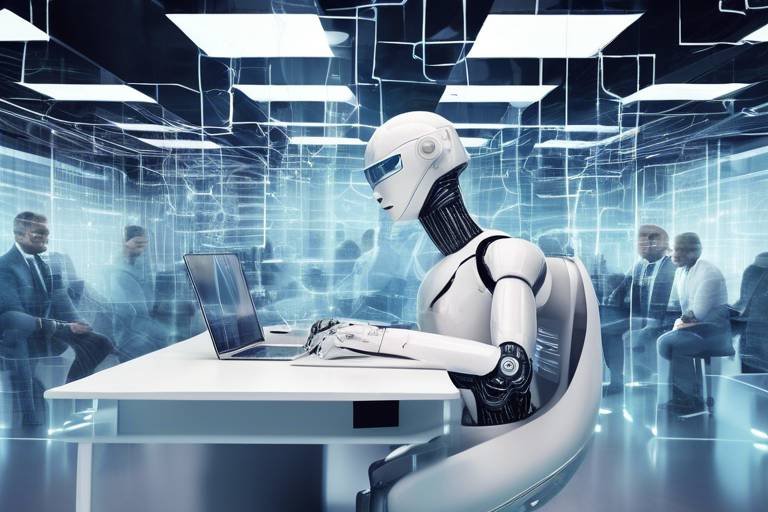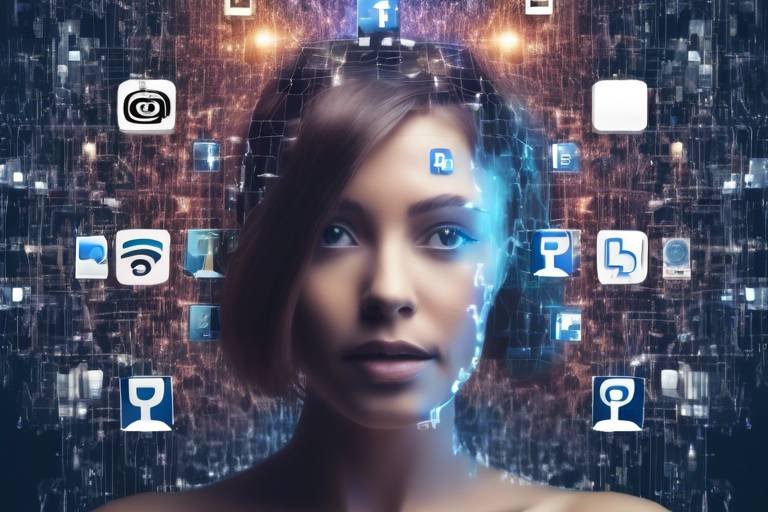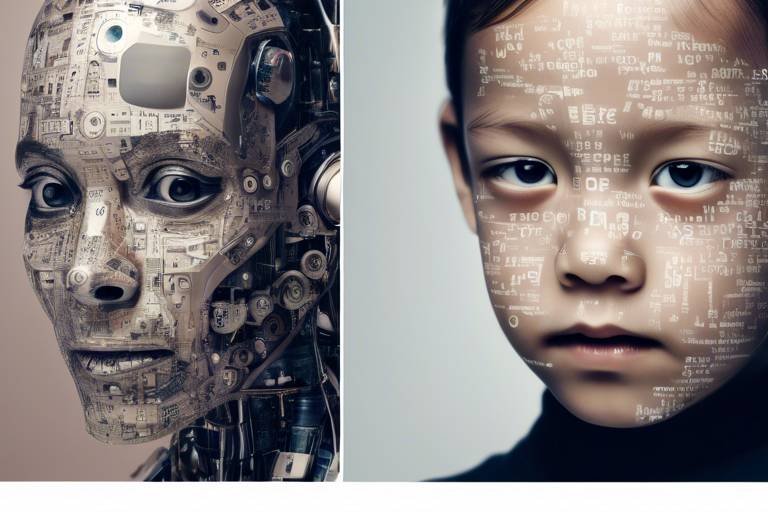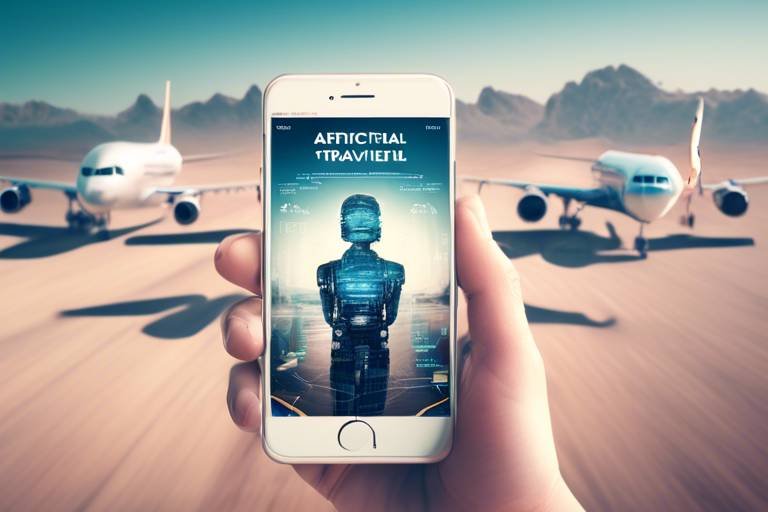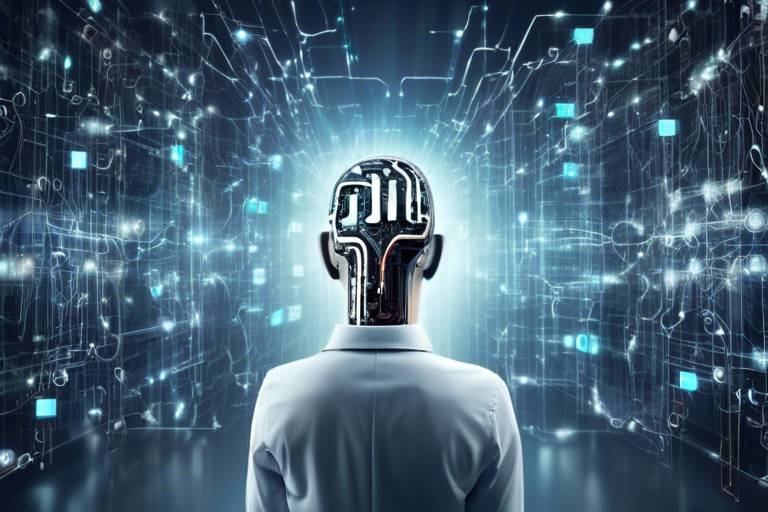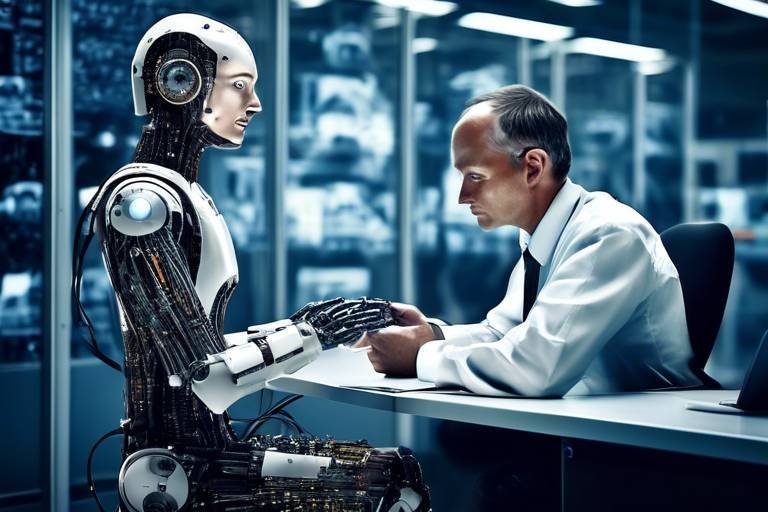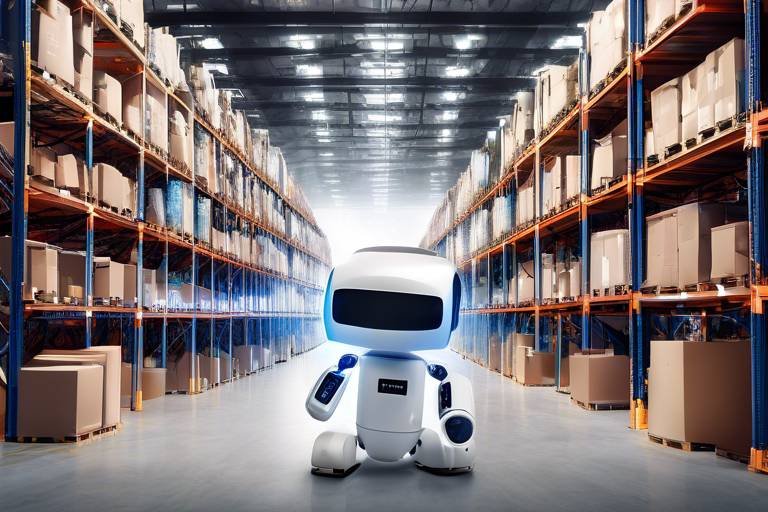The Future of Workplaces: An AI Perspective
Welcome to a new era where artificial intelligence is not just a buzzword but a transformative force reshaping our workplaces. Imagine walking into an office where your tasks are prioritized for you, where communication flows seamlessly, and where every employee's potential is maximized through tailored learning opportunities. Sounds like a scene from a sci-fi movie, right? But this is the reality we are stepping into, and it's happening faster than we can blink. In this article, we will explore how AI is enhancing productivity, influencing employee experiences, and what the future landscape of work environments will look like.
AI technologies are increasingly being integrated into daily operations, streamlining processes and improving efficiency. From chatbots that handle customer inquiries to sophisticated algorithms that optimize supply chains, AI is changing the game. Companies are now leveraging tools like machine learning and natural language processing to automate routine tasks, allowing employees to focus on more strategic initiatives. For instance, customer service departments are using AI to predict customer needs, enabling a proactive approach that enhances client satisfaction.
Consider the following applications that are revolutionizing traditional workplace dynamics:
- Automated Scheduling: Tools like x.ai and Clara are taking the headache out of meeting planning by automatically finding suitable times for all participants.
- Data Analysis: AI-driven analytics platforms help businesses make sense of vast amounts of data, providing insights that drive decision-making.
- Virtual Collaboration: Platforms like Slack and Microsoft Teams are incorporating AI features to improve communication and project management.
Remote work has become a staple in modern employment, and AI is playing a crucial role in making this transition smoother. With teams dispersed across various locations, the need for effective collaboration tools has never been more critical. AI facilitates remote collaboration and communication, ensuring that teams can function effectively regardless of where they are located. Imagine being able to work with a colleague halfway across the globe and feeling as if they are right next to you—AI is making that possible.
Collaboration tools powered by AI are enhancing teamwork in unprecedented ways. Popular platforms like Zoom and Trello are integrating AI features that help manage projects and facilitate communication. For example, AI can analyze meeting patterns, suggesting optimal times for future meetings based on team availability. These tools not only foster seamless communication but also ensure that everyone is on the same page, reducing the chances of miscommunication and enhancing productivity.
Virtual assistants are revolutionizing task management, acting as personal aides that handle everything from scheduling meetings to managing emails. Tools like Google Assistant and Amazon Alexa are becoming essential in the workplace, helping employees automate repetitive tasks that can consume valuable time. Imagine having an assistant that can remind you of deadlines, prioritize your tasks, and even draft emails for you. This level of support allows employees to focus on what truly matters—innovation and creativity.
Data analytics tools powered by AI provide profound insights into employee performance. By analyzing work patterns, AI can identify areas for improvement and suggest strategies to boost overall productivity. For instance, if an employee consistently struggles with time management, AI can recommend personalized training programs to enhance their skills. This data-driven approach not only helps individuals grow but also contributes to the organization's success.
While AI offers numerous benefits, its implementation poses challenges that organizations must navigate. These challenges include resistance to change, the need for upskilling employees, and concerns about data privacy. Companies must be proactive in addressing these obstacles to fully harness the power of AI in their workplaces. It's essential to foster a culture that embraces change and encourages continuous learning to ensure a smooth transition into an AI-driven environment.
AI is reshaping the employee experience in various ways, enhancing job satisfaction and workplace culture. By automating mundane tasks, employees have more time to engage in meaningful work, which can lead to higher job satisfaction. Furthermore, AI can provide valuable insights into employee needs and preferences, allowing organizations to create a more supportive work environment.
AI enables personalized learning experiences for employees, allowing organizations to tailor training programs based on individual skills and career goals. This approach not only enhances employee engagement but also ensures that team members are equipped with the necessary skills to thrive in their roles. Imagine a world where every employee has access to a learning path that aligns with their aspirations—this is the future that AI is paving the way for.
AI tools can help promote work-life balance by offering solutions that support employee wellbeing. For example, apps that monitor workload and suggest breaks can prevent burnout, while AI-driven wellness programs can provide personalized health recommendations. By prioritizing employee wellbeing, organizations can create a healthier workplace environment, leading to increased productivity and reduced turnover rates.
Q: How can AI improve productivity in the workplace?
A: AI can automate repetitive tasks, provide data-driven insights, and enhance collaboration, allowing employees to focus on more strategic initiatives.
Q: What are the challenges of implementing AI in the workplace?
A: Challenges include resistance to change, the need for employee training, and data privacy concerns.
Q: How does AI support remote work?
A: AI facilitates remote collaboration through tools that enhance communication, project management, and task automation.
Q: Can AI improve employee wellbeing?
A: Yes, AI can promote work-life balance by monitoring workloads, suggesting breaks, and providing personalized wellness recommendations.

AI Integration in Daily Operations
Artificial Intelligence (AI) is not just a buzzword anymore; it has become a game-changer in how organizations operate on a daily basis. Imagine walking into an office where mundane tasks are handled by intelligent systems, allowing employees to focus on more creative and strategic initiatives. This is the reality that many workplaces are beginning to embrace, and the benefits are hard to ignore. From automating repetitive tasks to providing insightful data analytics, AI technologies are reshaping the very fabric of workplace dynamics.
One of the most significant ways AI is integrated into daily operations is through automation tools. These tools can handle everything from scheduling meetings to processing invoices. For example, AI-powered software can analyze your calendar and suggest optimal meeting times, eliminating the back-and-forth emails that often waste precious time. This not only enhances productivity but also reduces the stress associated with managing busy schedules.
Moreover, AI-driven customer relationship management (CRM) systems are revolutionizing how businesses interact with their clients. These systems can analyze customer data and predict behavior, allowing organizations to tailor their marketing strategies effectively. By leveraging AI in this manner, companies can enhance customer satisfaction and build stronger relationships. The integration of AI into CRM systems is just one example of how technology can transform traditional business practices.
Additionally, AI is making waves in the realm of data analytics. Organizations are now able to gather and analyze vast amounts of data in real-time, providing insights that were previously unimaginable. For instance, AI can track employee performance metrics and identify trends that can lead to improved workflows. By understanding how employees work, organizations can implement changes that boost efficiency and morale. This data-driven approach not only enhances overall productivity but also fosters a culture of continuous improvement.
To illustrate the impact of AI integration in daily operations, consider the following table that summarizes key AI applications and their benefits:
| AI Application | Benefits |
|---|---|
| Automation Tools | Reduces time spent on repetitive tasks, allowing employees to focus on high-value work. |
| CRM Systems | Enhances customer relationships through personalized marketing and predictive analytics. |
| Data Analytics | Provides insights into employee performance and operational efficiency. |
As AI continues to evolve, it is clear that its integration into daily operations is not just a passing trend but a fundamental shift in how businesses operate. The potential for increased efficiency, better customer relations, and enhanced employee satisfaction is immense. However, it’s essential for organizations to approach AI integration thoughtfully, ensuring that the technology aligns with their overall business strategy and culture.

The Role of Remote Work
In today's fast-paced world, remote work has transitioned from a fleeting trend to a fundamental aspect of modern employment. With the advent of technology and the growing influence of artificial intelligence, businesses are embracing flexible work arrangements more than ever before. But what does this mean for employees and employers alike? Well, it turns out that AI plays a pivotal role in making remote work not just feasible, but also highly effective.
Imagine a workplace where your colleagues are scattered across various locations, yet you can collaborate seamlessly as if you were all in the same room. This is the magic of AI-driven tools that facilitate communication and project management. These tools have transformed traditional workplace dynamics, allowing teams to connect effortlessly, share ideas, and complete tasks efficiently, regardless of geographical barriers. For instance, platforms like Slack and Microsoft Teams are integrating AI features to enhance user experience, making it easier to manage conversations, prioritize tasks, and even automate reminders.
Moreover, remote work offers a plethora of benefits that go beyond mere convenience. It fosters a sense of autonomy and flexibility, allowing employees to craft their schedules around personal commitments. However, this newfound freedom comes with its own set of challenges, such as maintaining team cohesion and ensuring productivity. Here’s where AI steps in, providing solutions that help bridge the gap between remote teams. By analyzing communication patterns and work habits, AI can offer insights that help managers understand their teams better, ensuring that everyone stays connected and engaged.
Consider the following key aspects of how AI enhances remote work:
- Enhanced Communication: AI tools can summarize conversations, highlight action items, and even suggest optimal meeting times based on participants' calendars.
- Project Management: AI-driven platforms can assign tasks based on employee strengths and availability, streamlining workflows and ensuring that projects stay on track.
- Performance Insights: By analyzing productivity metrics, AI can provide feedback to employees, helping them identify areas for improvement and celebrate their successes.
As we look toward the future, it’s clear that the role of remote work will only continue to expand. Companies that embrace AI technologies will not only enhance their operational efficiency but also create a more inclusive work environment that values employee contributions, regardless of location. The synergy between remote work and AI is a game-changer, paving the way for a more dynamic, productive, and satisfying workplace experience.
- How does AI improve communication in remote work settings?
AI tools can automate summarization of discussions, suggest follow-up actions, and even analyze communication trends to enhance team interactions. - What are the challenges of remote work that AI can address?
AI can help mitigate challenges such as isolation, miscommunication, and productivity tracking by providing insights and facilitating better collaboration. - Can AI help with employee engagement in remote teams?
Absolutely! AI can analyze engagement levels and suggest strategies to improve team morale and connectivity.

AI-Driven Collaboration Tools
In today’s fast-paced work environment, are becoming essential for teams striving to enhance productivity and streamline communication. Imagine trying to coordinate a project with team members scattered across different time zones. It can feel like herding cats! But with the right AI tools, this chaos can transform into a well-oiled machine. These advanced technologies not only facilitate communication but also foster a culture of collaboration and innovation.
One of the standout features of AI-driven collaboration tools is their ability to analyze communication patterns and suggest improvements. For instance, tools like Slack and Microsoft Teams utilize AI to prioritize messages and highlight important threads, ensuring that no critical information slips through the cracks. This means that team members can focus on what truly matters, rather than sifting through endless notifications. Moreover, AI can automate routine tasks such as scheduling meetings, sending reminders, and even summarizing discussions, freeing up valuable time for employees to concentrate on their core responsibilities.
Let’s take a closer look at some popular AI-driven collaboration tools that are making waves in the workplace:
| Tool | Key Features | Benefits |
|---|---|---|
| Slack | AI-driven message prioritization, integrations with other apps | Improved communication, reduced email overload |
| Trello | Automated task assignments, progress tracking | Enhanced project management, visibility on tasks |
| Zoom | AI-powered background noise cancellation, transcription services | Clearer meetings, better note-taking |
These tools do more than just connect people; they create an ecosystem where ideas can flourish. For example, Trello’s ability to automate task assignments based on team members’ workloads means that everyone is working at their optimal capacity. This not only boosts productivity but also helps in maintaining a balanced workload, preventing burnout.
But the magic of AI doesn’t stop there. Many collaboration tools are now incorporating machine learning algorithms that can learn from user interactions. They adapt to individual preferences over time, making suggestions that can enhance team dynamics and project outcomes. Imagine a tool that knows your preferred working hours and automatically schedules meetings at those times, or one that can analyze past project data to recommend the best practices for future tasks. This level of personalization is a game-changer in how teams operate.
Furthermore, the integration of AI in collaboration tools also means enhanced security. With features like automated threat detection and real-time monitoring, teams can collaborate without the constant worry of data breaches or security threats. This peace of mind allows employees to focus on their work, knowing that their sensitive information is protected.
In conclusion, AI-driven collaboration tools are not just a trend; they are a vital component of modern workplaces. By enhancing communication, automating mundane tasks, and providing personalized experiences, these tools are helping teams work smarter, not harder. As we continue to embrace these technologies, the future of collaboration looks brighter than ever.

Virtual Assistants in the Workplace
In today's fast-paced work environment, virtual assistants have emerged as indispensable tools that are revolutionizing how we manage our daily tasks. Imagine having a personal assistant who never sleeps, is always available, and can handle a multitude of tasks simultaneously. This is exactly what AI-driven virtual assistants bring to the table. They are designed to automate mundane tasks, allowing employees to focus on more strategic initiatives that drive value for their organizations.
One of the most significant advantages of virtual assistants is their ability to streamline communication. Whether it's scheduling meetings, sending reminders, or managing emails, these assistants can handle it all with remarkable efficiency. For instance, instead of spending precious time coordinating schedules via back-and-forth emails, employees can simply instruct their virtual assistant to find a suitable time for everyone involved. This not only saves time but also reduces the frustration often associated with scheduling conflicts.
Moreover, virtual assistants can help in managing project deadlines and keeping track of important tasks. They can send alerts and notifications, ensuring that nothing falls through the cracks. Consider this: if you have a project with multiple moving parts, a virtual assistant can create a timeline, assign tasks to team members, and send reminders as deadlines approach. This level of organization can significantly enhance team productivity and ensure that projects are delivered on time.
Another fascinating aspect of virtual assistants is their ability to learn and adapt. Many of these tools utilize machine learning algorithms that allow them to understand user preferences and behaviors over time. For example, if a virtual assistant notices that you often schedule meetings on Tuesdays at 10 AM, it may start suggesting that time as a default option. This personalization not only improves efficiency but also enhances the overall user experience, making employees feel more in control of their schedules.
However, it’s essential to recognize that while virtual assistants can significantly enhance productivity, they are not without their challenges. Organizations must ensure that employees are trained to use these tools effectively, as a lack of familiarity can lead to underutilization. Additionally, there are concerns regarding data privacy and security, as virtual assistants often handle sensitive information. Therefore, companies must implement robust security measures and educate their employees about best practices when using these AI tools.
In conclusion, the integration of virtual assistants in the workplace represents a transformative shift in how we approach task management and communication. As these tools continue to evolve, they will undoubtedly play a crucial role in shaping the future of work, allowing employees to achieve greater productivity and focus on what truly matters—driving innovation and success within their organizations.
- What tasks can virtual assistants handle? Virtual assistants can manage scheduling, send reminders, handle emails, and even assist with project management.
- Are virtual assistants secure? While they can enhance productivity, organizations must implement proper security measures to protect sensitive data.
- Do I need training to use a virtual assistant? Yes, training can help employees maximize the benefits of virtual assistants and ensure they are used effectively.

Data Analytics for Productivity
In today’s fast-paced work environment, data analytics has emerged as a game-changer, particularly when it comes to enhancing productivity. Imagine having a personal coach that not only tracks your performance but also provides insights on how to improve. That’s exactly what AI-driven data analytics does for organizations. By analyzing vast amounts of data, these tools can identify patterns and trends that would be nearly impossible for humans to discern on their own.
One of the most significant advantages of leveraging data analytics in the workplace is the ability to pinpoint areas for improvement. For instance, analytics can reveal which tasks consume the most time, allowing teams to streamline their processes. This level of insight can lead to the optimization of workflows, which ultimately enhances overall productivity. Here are some key areas where data analytics can make a substantial impact:
- Performance Tracking: Organizations can monitor employee performance metrics in real-time, allowing for timely feedback and adjustments.
- Resource Allocation: Data analytics can help managers understand which teams or individuals are overburdened, enabling them to redistribute workloads effectively.
- Identifying Skill Gaps: By analyzing performance data, companies can identify skills that need development, leading to targeted training initiatives.
Moreover, data analytics tools can also predict future trends based on historical data. This predictive capability allows organizations to be proactive rather than reactive in their approach. For example, if data shows that a particular project consistently runs behind schedule, managers can investigate the root causes and implement changes before it becomes a recurring issue.
But it’s not just about numbers and graphs; the human element is crucial too. By providing employees with insights into their own performance, organizations can foster a culture of continuous improvement. Employees are more likely to feel engaged and motivated when they understand how their work contributes to the bigger picture. This sense of purpose can lead to increased job satisfaction and a more cohesive workplace culture.
To illustrate the impact of data analytics on productivity, consider the following table:
| Metric | Before Data Analytics | After Data Analytics |
|---|---|---|
| Average Task Completion Time | 5 hours | 3.5 hours |
| Employee Satisfaction Score | 65% | 80% |
| Project Overruns | 30% | 10% |
As shown in the table, the implementation of data analytics can lead to significant improvements across various productivity metrics. Companies that embrace these technologies not only enhance their operational efficiency but also create an environment where employees can thrive.
In conclusion, the integration of data analytics into workplace practices is not just a trend; it’s a necessity for organizations aiming to stay competitive. By harnessing the power of data, companies can make informed decisions that drive productivity, improve employee satisfaction, and ultimately lead to a more successful business. The future of work is undoubtedly data-driven, and those who adapt will reap the rewards.
- What is data analytics in the workplace? Data analytics in the workplace refers to the systematic computational analysis of data to improve decision-making and productivity.
- How can data analytics improve employee performance? By providing insights into work patterns and areas for improvement, data analytics helps employees understand their strengths and weaknesses, leading to enhanced performance.
- What tools are commonly used for data analytics? Some popular data analytics tools include Google Analytics, Tableau, and Microsoft Power BI.
- Is data analytics only for large companies? No, data analytics can benefit organizations of all sizes by helping them make data-driven decisions.

Challenges of AI Implementation
Implementing artificial intelligence in the workplace is not as simple as flipping a switch. While the potential benefits are enormous, organizations often encounter a myriad of challenges that can impede the smooth integration of AI technologies. One of the primary hurdles is the resistance to change among employees. Many workers may feel threatened by AI, fearing it could replace their jobs or alter their roles significantly. This can lead to a culture of skepticism, where employees are hesitant to embrace new tools and processes.
Another significant challenge is the cost of implementation. Developing and deploying AI solutions can require a substantial financial investment. Organizations must not only consider the initial costs of technology acquisition but also ongoing expenses related to maintenance, updates, and training. This can be particularly daunting for small to medium-sized enterprises (SMEs) that may not have the budget to support such initiatives.
Moreover, there is the issue of data quality and availability. AI systems rely on vast amounts of data to learn and make decisions. If the data fed into these systems is incomplete, outdated, or biased, the outcomes can be inaccurate or even harmful. Organizations must invest time and resources into ensuring their data is clean, relevant, and representative to harness the full potential of AI.
Additionally, regulatory and ethical considerations play a crucial role in AI implementation. With growing concerns about privacy and data security, businesses must navigate a complex landscape of regulations that govern how they can use AI technologies. This often means dedicating legal resources to ensure compliance, which can slow down the adoption process.
Lastly, there is the challenge of skills gaps. Not all employees are equipped with the necessary skills to work alongside AI technologies. Organizations must invest in training and development to upskill their workforce, ensuring that employees are not only comfortable using AI tools but can also interpret and act on the insights generated by these systems. Without proper training, the full potential of AI cannot be realized, and organizations may struggle to achieve their desired outcomes.
In summary, while the integration of AI into workplaces holds tremendous promise, organizations must navigate several challenges, including:
- Resistance to change from employees
- High costs of implementation
- Data quality and availability issues
- Regulatory and ethical considerations
- Skills gaps within the workforce
Addressing these challenges head-on is crucial for organizations looking to leverage AI effectively. By fostering a culture of openness, investing in employee training, and ensuring data integrity, companies can pave the way for a successful AI implementation that enhances productivity and employee satisfaction.
Q: What are the main challenges of implementing AI in the workplace?
A: The main challenges include resistance to change, high costs of implementation, data quality issues, regulatory and ethical considerations, and skills gaps within the workforce.
Q: How can organizations overcome resistance to AI?
A: Organizations can overcome resistance by fostering a culture of openness, providing clear communication about the benefits of AI, and involving employees in the implementation process.
Q: Why is data quality important for AI?
A: Data quality is crucial because AI systems rely on accurate and relevant data to learn and make decisions. Poor data can lead to incorrect outcomes and diminish the effectiveness of AI applications.
Q: What skills are necessary for employees to work effectively with AI?
A: Employees should develop skills in data analysis, critical thinking, and familiarity with AI tools and technologies to work effectively alongside AI systems.

The Impact on Employee Experience
Artificial Intelligence (AI) is not just a buzzword; it's a game-changer that is fundamentally altering the way we experience work. Imagine walking into an office where the technology not only understands your preferences but also tailors your work environment to enhance your productivity and satisfaction. Sounds futuristic, right? Well, that future is knocking on our doors today. AI is reshaping the employee experience in several significant ways, from personalized learning opportunities to fostering a healthier work-life balance.
One of the most exciting aspects of AI in the workplace is its ability to personalize learning and development. Traditional training programs often take a one-size-fits-all approach, which can leave many employees feeling unchallenged or overwhelmed. However, AI-driven platforms can analyze individual skills, career aspirations, and learning styles to create customized training paths. This means that instead of sifting through generic modules, employees can engage in targeted learning experiences that resonate with their personal and professional goals. For example, if an employee excels in data analysis but struggles with public speaking, AI can recommend tailored courses that enhance their communication skills while leveraging their analytical strengths.
Furthermore, AI plays a crucial role in promoting work-life balance and overall wellbeing. In today’s fast-paced work environment, it’s easy for employees to feel overwhelmed by the constant barrage of emails, meetings, and deadlines. AI tools can help mitigate this stress by automating repetitive tasks and managing schedules efficiently. Imagine having an AI assistant that not only reminds you of your meetings but also suggests optimal times for breaks and personal time, ensuring you don’t burn out. These tools are designed to support employees, helping them maintain a healthy balance between their professional and personal lives.
Moreover, AI can analyze workplace dynamics and employee feedback to identify areas where improvements are needed. This data-driven approach allows organizations to create a more inclusive and engaging work culture. For instance, AI can spotlight trends in employee satisfaction and highlight departments that may need additional support or resources. By addressing these issues proactively, companies can foster a positive work environment that values employee input and promotes a sense of belonging.
In summary, AI is not just enhancing productivity; it is fundamentally transforming the employee experience. By offering personalized learning opportunities and promoting work-life balance, AI is paving the way for a more fulfilling and engaging workplace. As we move forward, it’s essential for organizations to embrace these technologies thoughtfully, ensuring that they enhance the human experience rather than replace it.
- How does AI personalize employee training?
AI analyzes individual employee data, including skills and career goals, to create tailored learning experiences that cater to their specific needs.
- Can AI really help with work-life balance?
Yes! AI tools can automate repetitive tasks and manage schedules, allowing employees to focus on their work while also ensuring they take necessary breaks.
- What role does AI play in employee feedback?
AI can analyze feedback and satisfaction trends to identify areas for improvement, helping organizations create a more positive work environment.

Personalized Learning and Development
In today’s fast-paced work environment, the idea of one-size-fits-all training programs is becoming a thing of the past. Companies are increasingly recognizing that their employees have unique skills, learning styles, and career aspirations. This is where artificial intelligence steps in, offering a tailored approach to employee development that not only enhances individual performance but also drives organizational success.
Imagine walking into a training session where everything is designed just for you. That’s the promise of AI-driven personalized learning. By analyzing data on employee performance, learning preferences, and even feedback from past training sessions, AI can create customized training paths. For example, if an employee excels in analytical tasks but struggles with public speaking, the AI can suggest specific courses and resources that target those areas, making learning more relevant and impactful.
Moreover, AI can help organizations identify skill gaps within their teams. By continuously monitoring performance metrics, AI tools can highlight areas where employees may need additional training. This proactive approach not only fosters a culture of continuous improvement but also ensures that employees feel valued and supported in their career journeys. Here’s how it typically works:
| Step | Description |
|---|---|
| Data Collection | AI gathers data on employee performance, preferences, and feedback. |
| Analysis | AI analyzes the data to identify individual strengths and weaknesses. |
| Personalized Recommendations | AI suggests tailored training programs and resources. |
| Monitoring Progress | AI tracks employee progress and adjusts recommendations as needed. |
This personalized approach not only enhances the learning experience but also promotes higher levels of engagement among employees. When individuals feel that their unique needs are being addressed, they are more likely to be motivated and invested in their own development. It’s like having a personal coach who knows exactly what you need to succeed!
Furthermore, the integration of AI in learning and development can lead to a more inclusive workplace. By providing tailored learning experiences, organizations can accommodate diverse learning styles and paces, ensuring that all employees have the opportunity to thrive. This is particularly important in a global workforce where cultural differences can influence how people learn and interact.
In conclusion, the future of workplace learning is undoubtedly personalized, thanks to the power of AI. By leveraging technology to create customized learning experiences, organizations can not only enhance employee skills but also foster a culture of continuous growth and improvement. As we move forward, embracing this innovative approach will be crucial for both employee satisfaction and business success.
- How does AI personalize learning experiences?
AI analyzes employee data and performance metrics to create tailored training programs that address individual strengths and weaknesses. - What are the benefits of personalized learning?
Personalized learning increases engagement, improves skill development, and fosters a more inclusive workplace culture. - Can AI help identify skill gaps?
Yes, AI tools continuously monitor employee performance and can highlight areas that require additional training. - Is personalized learning more effective than traditional methods?
Personalized learning is often more effective as it aligns with individual needs, making learning more relevant and impactful.

Work-Life Balance and Wellbeing
In today's fast-paced world, the quest for a healthy work-life balance has become more critical than ever. With the rise of artificial intelligence (AI) tools, organizations are beginning to recognize the potential of technology to promote employee wellbeing. Imagine a workplace where technology not only helps you get your job done but also cares for your mental and physical health. Sounds like a dream, right? Well, it's becoming a reality!
AI applications are designed to assist employees in managing their time and workloads more effectively. For instance, smart scheduling tools can analyze your calendar and suggest optimal times for meetings, breaks, and even personal time. This can help prevent burnout, which is a growing concern in many industries. By using AI to optimize schedules, employees can enjoy a more balanced workday, allowing them to focus on both professional responsibilities and personal interests.
Furthermore, AI-driven wellness programs are emerging as essential components of modern workplaces. These programs can track employee health metrics, such as stress levels and physical activity, and offer personalized recommendations for improvement. For example, if an employee is consistently working long hours without breaks, AI can suggest reminders to take short walks or engage in mindfulness exercises. This not only boosts productivity but also fosters a culture of wellbeing within the organization.
One of the most exciting aspects of AI in promoting work-life balance is its ability to personalize experiences. AI can analyze individual preferences and work habits to create tailored recommendations for each employee. This could include customized training programs, flexible work hours, or even suggestions for team-building activities that align with personal interests. By catering to the unique needs of employees, organizations can create a more inclusive and supportive environment.
Moreover, AI can facilitate better communication between team members, reducing misunderstandings and fostering a sense of community. With tools that analyze communication patterns, AI can identify potential issues and suggest interventions before they escalate. This proactive approach not only enhances collaboration but also contributes to a healthier workplace culture where employees feel valued and understood.
In summary, the integration of AI into workplace practices is revolutionizing how we approach work-life balance and employee wellbeing. By leveraging technology to create personalized experiences, optimize schedules, and foster communication, organizations can cultivate a healthier, happier workforce. As we move forward, embracing these AI-driven solutions will be essential for creating work environments that support both productivity and personal fulfillment.
- How can AI help improve work-life balance? AI can optimize schedules, suggest breaks, and provide personalized wellness recommendations to help employees manage their time better.
- What are some examples of AI tools for employee wellbeing? Tools like smart scheduling apps, wellness tracking programs, and communication analytics platforms are designed to enhance employee wellbeing.
- Can AI replace human interaction in the workplace? While AI can facilitate communication and provide insights, it is not a replacement for human interaction, which remains crucial for building relationships and fostering a positive workplace culture.
- What role does personalization play in AI applications for work-life balance? Personalization allows AI to tailor recommendations and solutions based on individual needs and preferences, making it more effective in promoting wellbeing.
Frequently Asked Questions
- How is AI changing the way we work?
AI is transforming workplaces by automating routine tasks, enhancing productivity, and facilitating better communication. It streamlines processes, allowing employees to focus on more strategic and creative aspects of their jobs. Imagine having a digital assistant that handles scheduling and reminders—suddenly, you have more time to innovate!
- What are some popular AI-driven collaboration tools?
There are several AI-driven collaboration tools that are gaining traction, including platforms like Slack, Microsoft Teams, and Trello. These tools use AI to improve communication, manage projects, and even analyze team performance to suggest improvements. It’s like having a personal coach for your team dynamics!
- Can AI help with remote work?
Absolutely! AI enhances remote work by providing tools that facilitate seamless communication and collaboration among team members, no matter where they are. Think of it as a virtual office that connects everyone, making sure no one feels isolated. AI tools can also help in managing workloads and ensuring deadlines are met.
- What challenges might organizations face when implementing AI?
While AI brings many benefits, organizations can encounter challenges such as resistance to change, data privacy concerns, and the need for employee training. It’s crucial to address these challenges proactively to ensure a smooth transition into an AI-enhanced workplace.
- How does AI impact employee experience?
AI significantly enhances employee experience by personalizing learning and development opportunities, improving job satisfaction, and promoting work-life balance. With AI, employees can receive tailored training that aligns with their career goals, making them feel valued and engaged in their work.
- What role do virtual assistants play in the workplace?
Virtual assistants are game-changers in workplaces, helping employees manage their tasks more efficiently. They can schedule meetings, sort through emails, and automate repetitive tasks, allowing employees to dedicate more time to high-impact activities. It’s like having a personal secretary who never sleeps!
- Can AI tools support employee well-being?
Yes, AI tools can promote employee well-being by providing insights into work patterns and suggesting breaks or adjustments to workloads. They can help create a healthier work environment by encouraging a better work-life balance, which is essential for overall employee satisfaction.

